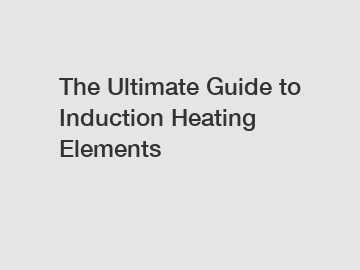The Ultimate Guide to Induction Heating Elements
Induction heating is a widely used method of heating in industries ranging from manufacturing to food processing. Its popularity stems from its efficiency, precision, and ability to quickly and uniformly heat materials. Central to the effectiveness of induction heating is the induction heating element, which plays a crucial role in the heating process. In this ultimate guide, we will explore everything you need to know about induction heating elements.
Induction heating elements are coils made from conductive materials such as copper or aluminum. When an alternating current (AC) flows through the coil, it generates a rapidly alternating magnetic field. When a conductive material is placed within this magnetic field, eddy currents are induced in the material, causing it to heat up. This is the basic principle behind induction heating.
There are several types of induction heating elements, each designed for specific applications. The most common types include:

1. Solid-state induction heating elements: These elements consist of a solid piece of conductive material, typically copper, wound into a coil. They are used in applications where high power and fast heating are required. Solid-state elements are highly efficient and can withstand high temperatures.
2. Water-cooled induction heating elements: These elements have a hollow design that allows water to flow through them, keeping them cool during operation. Water-cooled elements are used in high-power applications where cooling is necessary to prevent overheating.
3. Air-cooled induction heating elements: These elements are designed to dissipate heat through natural convection and are suitable for low to medium-power heating applications. Air-cooled elements are easy to install and do not require additional cooling systems.
4. Flexible induction heating elements: These elements are made of flexible materials such as silicone or fiberglass and can be bent or shaped to fit specific contours. They are often used in applications where the heating element needs to conform to irregular shapes or be easily removable.
Choosing the right type of induction heating element depends on factors such as the required power output, heating time, material compatibility, and operating environment. It's essential to consult with a heating expert to determine the best heating element for your specific needs.
In addition to selecting the right type of induction heating element, proper design and installation are crucial for maximizing efficiency and performance. Here are some tips for ensuring optimal results with your induction heating system:
1. Size the induction heating element correctly: It's essential to choose an element that matches the size and shape of the material being heated. Oversized or undersized elements can result in uneven heating or inefficient energy use.
2. Maintain the induction heating element: Regular inspection and maintenance of the heating element are critical for ensuring its longevity and performance. Check for any signs of wear or damage and replace the element if necessary.
3. Monitor the temperature: Use temperature sensors to monitor the heating process and ensure that the material reaches the desired temperature consistently. This will help prevent overheating and ensure uniform heating.
4. Optimize the power output: Adjust the power output of the induction heating system according to the material being heated and the desired heating rate. Higher power settings can speed up the heating process, but may also increase energy consumption.
In conclusion, induction heating elements are an essential component of induction heating systems, playing a vital role in achieving efficient and uniform heating. By choosing the right type of element, properly sizing and maintaining it, and optimizing the heating process, you can maximize the performance of your induction heating system. For expert advice on selecting and using induction heating elements, consult with a reputable heating specialist.
For more information, please visit medium frequency annealing equipment, custom screw rod high frequency quenching company, pancake induction coil design.
89
0
0


Comments
All Comments (0)